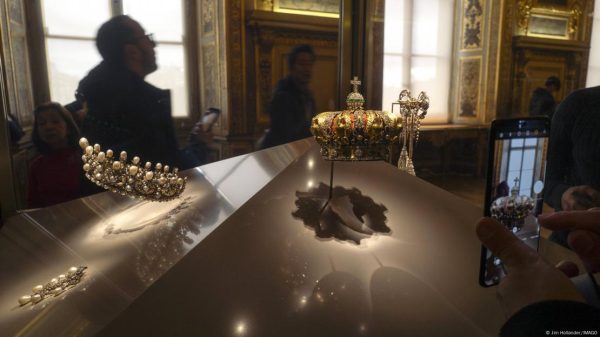OU hosts speaker discussing her book on Yumeji design
Photo Courtesy of Object Lessons Space
Nozomi Naoi stands next to some of her art collection.
Oakland University’s Art and Art History Department hosted an online lecture featuring Nozomi Naoi, an assistant professor of humanities at Yale-NUS College.
The lecture, which was presented on behalf of OU’s Jean S. and Fred M. Braun Memorial, featured Naoi live from her Singapore office, where she brought to life her book: “Yumeji Modern: Designing the Everyday in Twentieth Century Japan.”
Her lecture consisted of an introduction to Takehisa Yumeji’s life and works, Yumeji-style, graphic arts in the emerging media landscape and a look at the Great Kanto Earthquake series.
Naoi specialized in modern Japanese art and the surrounding media environment in Asia. She has received the first Takehisa Yumeji Research Society Award for contributing to the Nihon no Hanga Museum exhibition, and her latest project focused on Japanese poster design and global modernism during the twentieth century.
“Takehisa Yumeji was an emblematic figure,” Naoi said. She described his graphic works as developing in association with the emerging media scape of the 1900s and 1910s, “when novel forms of reprographic media were enabling the creation of new spaces of visual culture and image circulation.”
Naoi described Yumeji’s works as ranging from socialist messages such as images of anti-war, all the way to his devastating portrayal of the Great Kanto earthquakes in the Tokyo region.
Yumeji’s work was also known for images of beautiful women described as “Yumeji-style beauty.” The Yumeji-style was considered to be one of the more popular aspects of Yumeji’s career as it dealt with women as both the subject and audience. This created a popular beauty standard for women in Japan and was sought after by women of every background and class.
“Fashionable images of beautiful women … were in books and magazines targeting a female audience,” said Naoi. “Yumeji-style provided an entry point for his female consumers to project their own identities onto images of ordinary girls who were given central focus and attention in his work.”
Naoi highlighted Yumeji’s commercial success in branding and selling his popular Yumeji-style. His brand was extremely popular in the twentieth century, consisting of items all the way from lithographs to clothes.
“By purchasing Yumeji goods from [the department store] Minatoya, consumers were able to inhabit the space of the Yumeji-style beauty and in association become one,” said Naoi.
Naoi talked about some of the beginning chapters in her book, discussing Yumeji’s relationship between his illustrations, socialist bulletins and mass media. These works laid the foundations in discovering his subject matter and audience.
“Yumeji’s illustrations demonstrate his strong anti-war stance and his support for the day-to-day lives of the average person,” said Naoi. “They display a more serious, political side of the artist still little discussed by scholars today.”
Naoi discussed Yumeji’s larger role in commercial design after being recognized for his illustrations and connection with the common people of Japan. Yumeji was recognized for his creation of music sheets and promotional magazines for department stores in Japan.
The music sheets created by Yumeji allowed a wider audience to experience contemporary tunes that were otherwise too expensive for the lower classes.
“The Sinome company enlisted a number of artists to illustrate its score’s covers, however, Yumeji was the most popular with over 270 designs,” Naoi said.
The department store began to rise in popularity throughout the twentieth century, and Naoi described it as a large aspect of urbanizing Japan. It catered to a broader audience such as the growing middle class. Naoi illustrated that these department stores brought a more western-style approach to living and popularized a consumer culture.
“Yumeji’s involvement with the Mitsukoshi Magazine tied together the appeal of his female imagery with the more concrete elements of fashion and consumer items that could be attached to the branding of his Yumeji-style,” Naoi said.
Naoi wrapped up her lecture with a discussion about her book’s final chapters on Yumeji’s overall eclectic style seen in his Great Kanto Earthquake series. This series of works consisted of 21 issues and brings in both Yumeji’s political and social ideas developed since his beginning illustrations.
“This series demonstrates Yumeji’s comradery with his fellow Tokyoites and the struggles that the survivors faced as the city, region and nation attempted to come to terms and recover from the disaster,” Naoi said.
After Naoi’s presentation, she was able to do a brief Q&A with the participants. The viewers were able to ask questions and Naoi answered as many as she could, giving the participants some insight into her podcast and website. Both the listeners and Naoi thanked each other for the lecture and opportunity.








